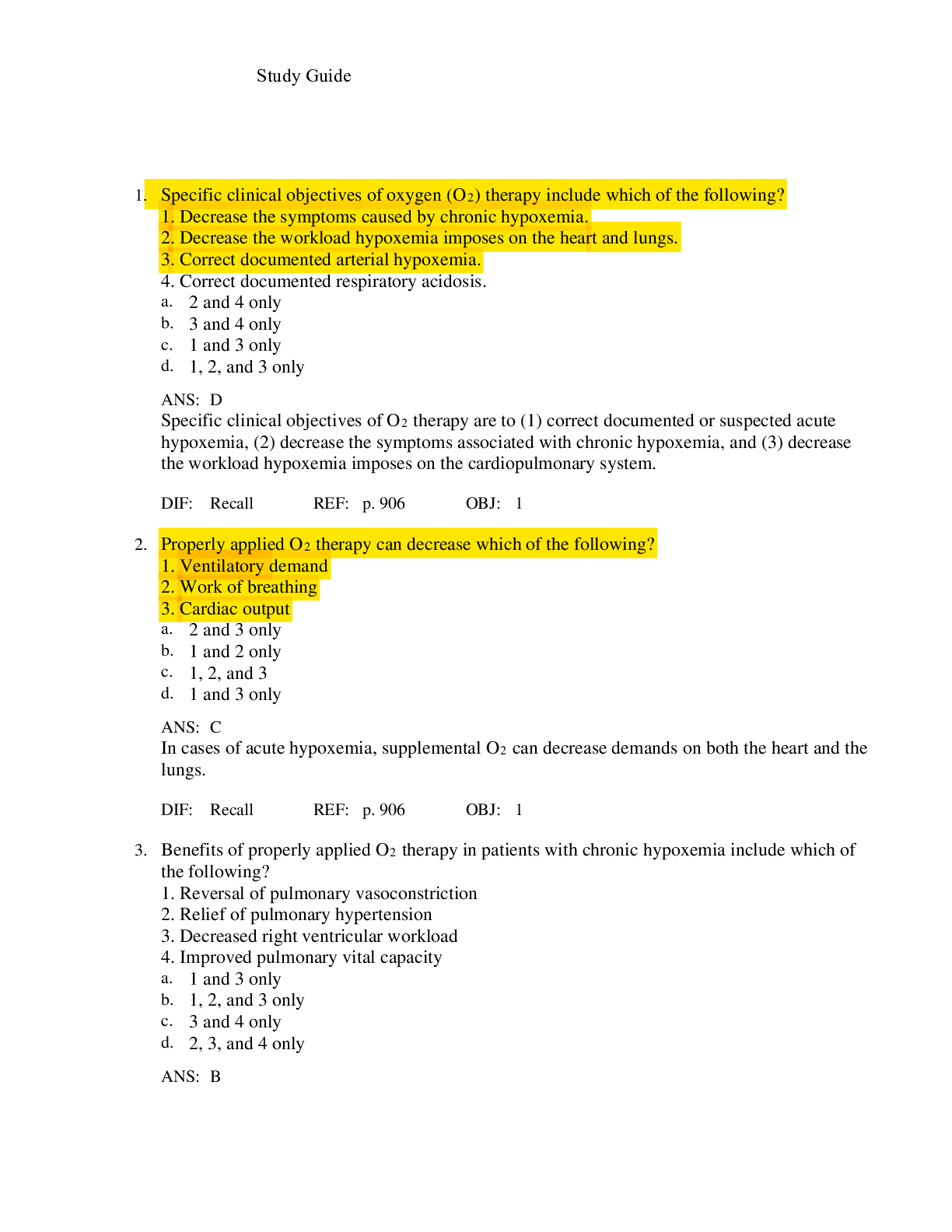Health Care > EXAM > Pharmacy Tech-Exam- Study Guide Latest Updated Graded A+ (All)
Pharmacy Tech-Exam- Study Guide Latest Updated Graded A+
Document Content and Description Below
Occupational Safety and Health Administration (OSHA) - ANSWER ensure safe and healthful working conditions for workers by setting and enforcing standards and by providing training, outreach, education... , and assistance Personal Protective Equipment (PPE) - ANSWER protective clothing, hats, helmets, googles, and equipment Safety Data Sheet (SDS) - ANSWER is a detailed informational document prepared by the manufacturer or importer of a hazardous chemical. Hazardous materials and chemicals - ANSWER should be stored separately from other materials. must labeled in a leakproof container possibly in a negative pressure room Non-hazardous waste - ANSWER materials used to prepare a compounded product to products that have passed their intended expiration date. Pharmaceutical Substance - ANSWER any substance used for therapeutic treatment. medications or the ingredients used to make them Vaccines, syringes, and needles - ANSWER must be disposed of in a sharps container to prevent an accidental needle stick Two types of Pharmaceutical Substances - ANSWER Hazardous (warfarin) and Non-Hazardous (amoxicillin) Controlled Substances are kept - ANSWER vault or locked cabinet, where certain controlled medications are segregated to maintain accurate inventory and reduce the potential for diversion. Controlled Substances are - ANSWER high risk for abuse and misuse Movement of Controlled Substances - ANSWER regulated by the DEA and each step must be traceable Schedule II Prescriptions - ANSWER must be sent electronically or handwritten on a secure prescription blank if practitioner has a waiver on file. faxes are only accepted for hospice or long-term care patients. Telephonic emergency Schedule II - ANSWER prescriptions are limited to a 72-hour supply or enough to cover the emergency period Verbal emergency Schedule II prescriptions - ANSWER must be followed up with an electronic or hard copy per DEA regulations combat the current opioid crisis - ANSWER limit the day's supply and number of opioid(s) that can be prescribed to 100 morphine milliequivalents (MME) per day. Anything above this amount would require a certain exemption and ICD-10 code. Can a Schedule II prescription be altered? - ANSWER No, a need prescription would need to be sent Experiation Date for C2 varies by state, what is it in Texas? - ANSWER 21 days Pharmacies must follow both - ANSWER Federal and State Regulations Schedule III-V prescriptions - ANSWER May be written, verbal, faxed, electronic Refills up to 5 times or 6 months Schedule II prescriptions can/cannot be refilled - ANSWER cannot, nor can they be transferred Can controlled substances be filled early? - ANSWER Yes 3 days earlier unless otherwise stated by the prescriber Schedule III-V transfers - ANSWER Transfers one time only unless pharmacies share common database. if the prescription was never initially filled, it is non-transferable The following needs to be included when transferring a prescription: - ANSWER Original prescription date and dispensing date Number of refills remaining The name of the transferring pharmacist The DEA number, name, and address of the transferring pharmacy opioid prescriptions cannot exceed - ANSWER 100MME Drug Enforcement Administration (DEA) - ANSWER The federal agency responsible for enforcing the nation's laws and regulations regarding narcotics and other controlled substances. Prescription Monitoring Program (PMP) - ANSWER must report all controlled rxs (CII-CV) black box warning - ANSWER aim to alert healthcare providers and consumers of serious potential adverse effects or life-threatening risks FDA (Food and Drug Administration) - ANSWER responsible for regulating the safety and efficacy of medical devices, drugs, and biologics Opioid Analgesic Risk Evaluation and Mitigation (REMS) - ANSWER program that requires adequate training be available for healthcare professionals who manage pain DEA 222 form - ANSWER Used to order CI & II or to transfer to another registrant Labeling Controlled Substances - ANSWER Fill date Pharmacy name & address Prescription number Patient name Prescribing practitioner Drug name, strength, dosage form, quantity, and number of fills (if CIII-V) Directions for use & any applicable cautionary verbiage and a warning Patient pickup of a controlled substance - ANSWER must show a valid federally-issued identification DEA 41 form is for? - ANSWER outdated, expired controlled substances DEA 106 form used for? - ANSWER To report theft or loss of drugs to DEA of controlled substances Combat Methamphetamine Epidemic Act of 2005 (CMEA) - ANSWER Regulates the over the counter sales of ephedrine and pseudoephedrine. Limited to 30 days. Daily supply = 3.6g Mail Order = 7.5g Retail = 9g The Risk Evaluation and Mitigation Strategies (REMS) - ANSWER FDA and drug manufacturers helps limit inappropriate dispensing and protects patients Medication Recalls - ANSWER contact all patients who might have been affected and reconcile the need for the recall. All recall records should be maintained in a similar manner as that for prescriptions. Medication Recall Class III - ANSWER problem that's not likely to cause any adverse effects Medication Recall Class II - ANSWER temporary (but reversible) chance of adverse effect or little chance of serious adverse effect Medication Recall Class I - ANSWER strong chance of serious adverse effects or death Being familiar with common pharmaceutical names and spellings - ANSWER will make it easier to understand patients and communicate with other healthcare professionals Generic drugs are - ANSWER less expensive chemically the same as brand name drugs A medication is produced under its brand name only while under patent (~20 years) - ANSWER after that a generic can be made Medication Classification - ANSWER It indicates the effect of the medication on a body system, the symptoms the medication relieves, or the medication's desired effect. Therapeutic Equivalence - ANSWER • Same active ingredients • Same dosage form • Same route of administration • Identical in strength/concentration • May differ in shape, scoring configuration, packaging, and color • Must have same clinical effect Drug interactions - ANSWER occur when a drug reacts with another drug, food, or dietary supplement to increase or decrease the effect of one of the substances Drug-Disease Interactions - ANSWER may occur when a prescription or an over-the-counter medication interacts or interferes with an existing medical condition drug-drug interactions - ANSWER when one drug changes the way another drug affects the body Drug/dietary interactions - ANSWER When elements of ingested nutrients interact with a drug and this affects the disposition of the drug Drug-laboratory interactions - ANSWER Drugs may cause misinterpretation of test results. Drug-Nutrient Interactions - ANSWER Food may increase, decrease, or delay drug response Drug Strength - ANSWER amount of active drug in any given dosage form dosage form - ANSWER form in which drugs are manufactured; includes elixirs, tablets, capsules, suppositories, parenteral drugs, and transdermal systems Administration routes - ANSWER IV, oral, subcutaneous injection, intramuscular, sublingual, topical Special Administration and handling - ANSWER refrigerate, shake well, etc Calculations to know - ANSWER 1 mL = 20 drops 1 teaspoon = 5 mL 1 tablespoon = 15 mL 1 kg = 2.2 lb 1 in = 2.54 cm 1 oz = ~30 mL 1 pt = 473 mL Example 1: A patient is prescribed the following: Drug: morphine sulfate 100 mg/5 mLDirections: 5 mg by mouth every 2 hours as neededDispensed quantity: 30 mLWhat is the day supply? - ANSWER 100 mg/5 mL = 20 mg/mL, so 5 mg = 0.25 mL; 0.25 mL x 12 hours = 3 mL total per day. 30 mL/3 mL = 10 days. This means that 30 mL will last the patient a minimum of 10 days. Example 2: A patient is prescribed enoxaparin (100 mg/ml) 1 mg/kg subcutaneously every 12 hours for 7 days. The patient weighs 154 lb. What is the dosing of enoxaparin? - ANSWER 154 lb/2.2 = 70 kg; 1 mg x 70 kg = 70 mg; 70 mg every 12 hours for 7 days. Adverse Reactions/side effects - ANSWER a list of possible unpleasant or dangerous secondary effects other than the desired effect drug stability - ANSWER the ability of the pharmaceutical dosage form to maintain the physical, chemical, therapeutic, and microbial properties during the time of storage and usage by the patient Reconstitutables - ANSWER - Provided from the manufacturer in a powdered form and a certain amount of distilled water must be added -Typically these must be reconstituted when the patient arrives to pick up (They have a short shelf life and often need to be refrigerated) Narrow Therapeutic Index (NTI) - ANSWER Drugs with small differences in dose or blood concentration may lead to dose and and blood concentration dependent, serious therapeutic failures / adverse drug reactions incompatibility - ANSWER two medications are mixed with each other and resulting in an unsuitable product, either by physical or chemical means Physical incompatibility signs - ANSWER Formation of a precipitate A color change from the original product Separation of the ingredients Unexpected cloudiness chemical incompatibility signs - ANSWER Change in pH Decomposition/degradation Hydrolysis Oxidation-reduction reactions Medication storage - ANSWER kept at room temperature, under refrigeration, or in the freezer depending upon drug storage requirements room temperature - ANSWER 68-77 F 20-25 C light sensitive medication - ANSWER have special storage requirments and use amber bottles to lessen light exposure Non-sterile compounding - ANSWER any preparation that does not meet the standards for sterile compounding and must follow USP 795 regulations Steps for non sterile compounding - ANSWER Using the prescription, create a formula for the intended product including any calculations and specific amounts of ingredients needed. Wash hands and put on all required PPE. Obtain any hardware supplies such as a balance or graduated cylinder. Weigh/measure out all ingredients using the proper measurement tools. Following the recipe, combine the ingredients in the correct ratios and in the proper order. Document the exact amounts used and label the final product including final strengths of ingredients. Ointments are - ANSWER medication preparations used topically to treat dermatologic conditions. oil based Ointments are made - ANSWER by process of spatulation is used, which is the mixing of semi-solids and powders on an oil slab by use of a spatula. The mixing during this process must be geometric, meaning small equal parts of each ingredient are mixed at a time to obtain a uniform mixture until all ingredients are integrated into the mixture Mixtures are - ANSWER numerous active and inactive ingredients to formulate a compound Suspensions are - ANSWER simple pharmacy mixture that is composed of a medication in powder form that is suspended in a liquid vehicle, typically sterile water Liquids are - ANSWER composed of a solute and solvent. Emulsions are - ANSWER two liquid substances that are immiscible, meaning they do not mix together. typically used as topical formulations as creams and as bases in ointments or lotions. [Show More]
Last updated: 2 years ago
Preview 1 out of 21 pages
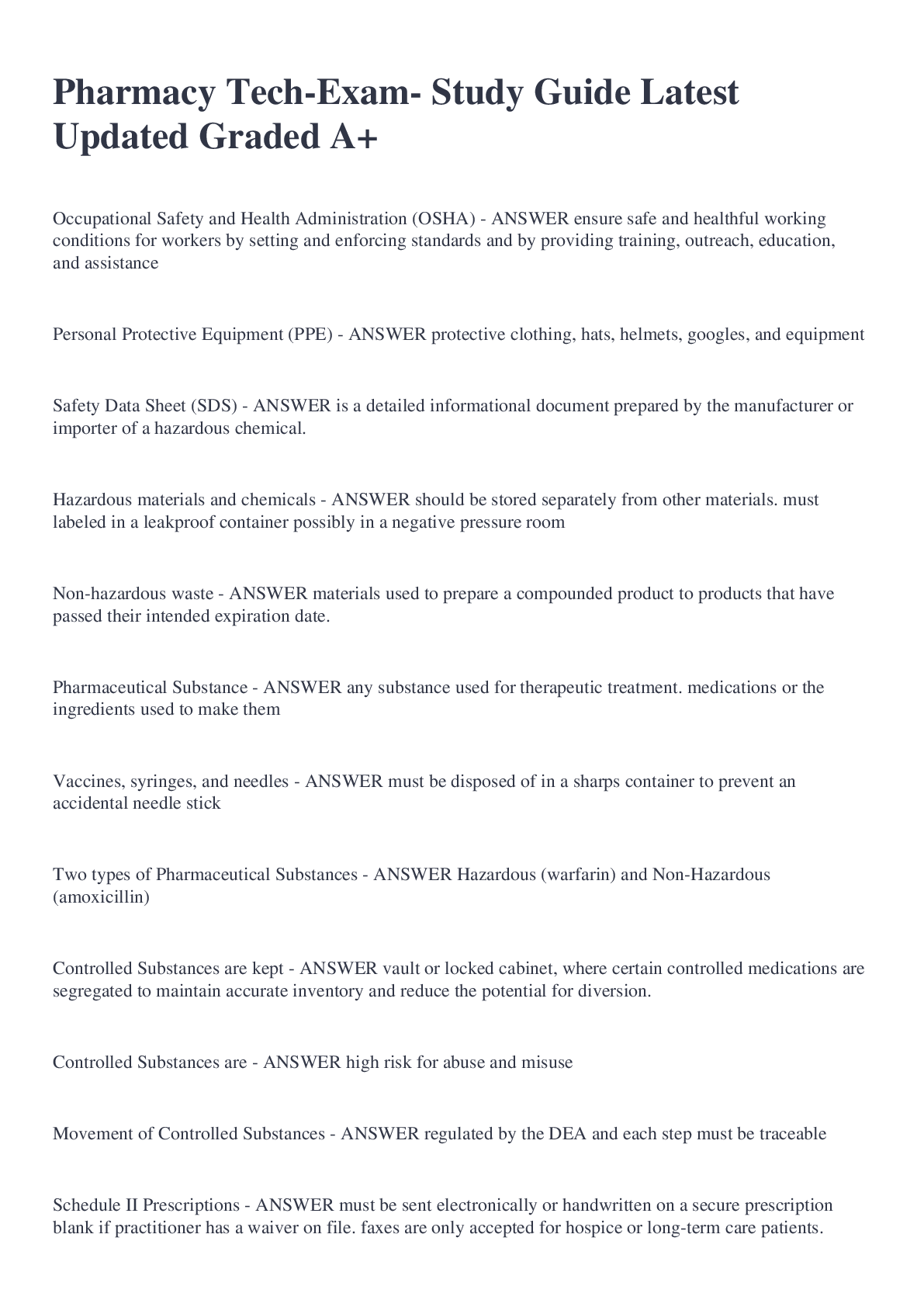
Buy this document to get the full access instantly
Instant Download Access after purchase
Buy NowInstant download
We Accept:

Reviews( 0 )
$8.00
Can't find what you want? Try our AI powered Search
Document information
Connected school, study & course
About the document
Uploaded On
Oct 02, 2022
Number of pages
21
Written in
Additional information
This document has been written for:
Uploaded
Oct 02, 2022
Downloads
0
Views
44



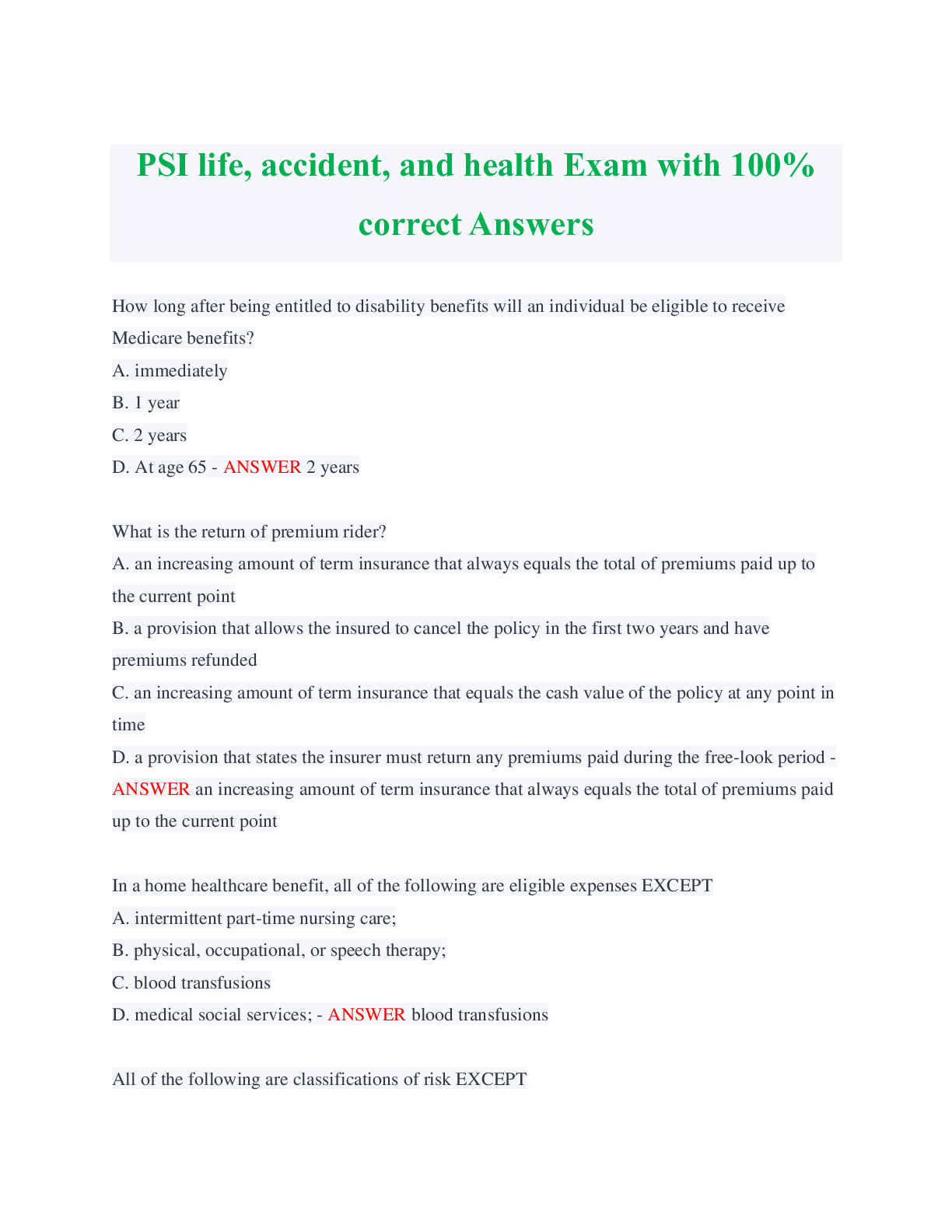














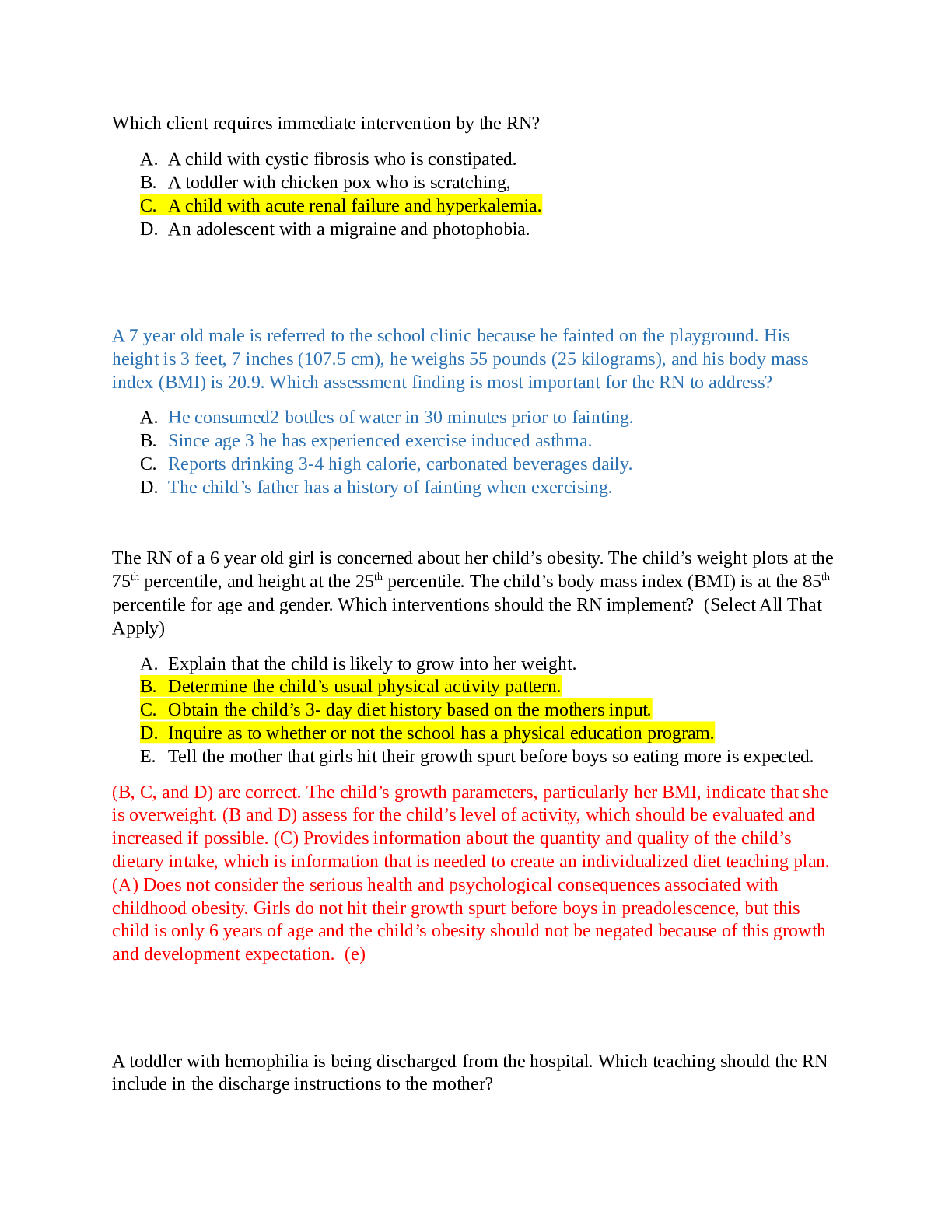
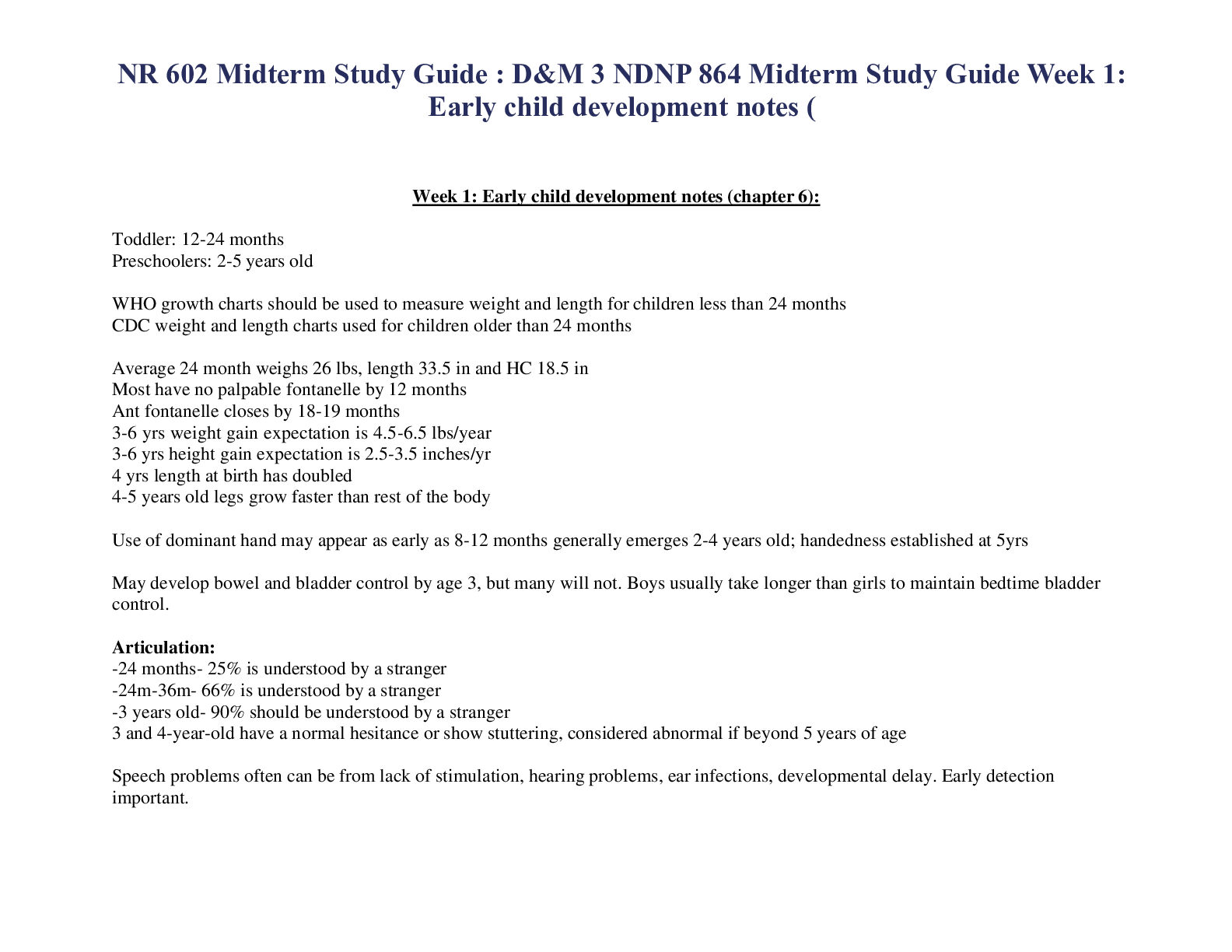
.png)



